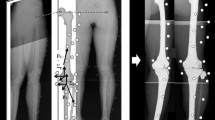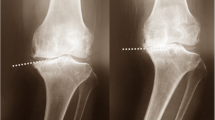Abstract
Purpose
To test the hypothesis that an inclined articular surface on the medial proximal tibia is aligned more parallel to the ground in three-dimensional (3D) space under weight-bearing (WB) conditions (parallel phenomenon) than under non-WB (NWB) conditions in healthy and varus osteoarthritic knees.
Methods
We examined 55 healthy knees (26 women, 29 men; mean age, 70 ± 6 years) and 108 varus osteoarthritic knees (66 women, 16 men; mean age, 74 ± 7 years). For the evaluation under WB conditions, a 3D assessment system was used on biplanar long-leg radiographs and 3D bone models using a 3D-to-2D image registration technique. In addition, the least square method was used to determine the approximation plane. The angles between the normal vector for the approximation plane of an articular surface on the medial proximal tibia and each axis of the tibial or world coordinate system were calculated.
Results
Morphologically, the inclination of the approximation plane was steeper in osteoarthritic knees than in healthy knees (p < 0.0001). The approximation plane was aligned more parallel to the ground under WB conditions than under NWB conditions in healthy (p < 0.0001) and osteoarthritic knees (p < 0.0001).
Conclusions
The parallel phenomenon in the medial proximal tibia was confirmed for healthy and varus osteoarthritic knees. The medial proximal tibia plays an important role in the parallel phenomenon, assumingly associated with varus alignment and varus thrust. The inclination of the medial proximal tibia may become a new parameter for imaging investigations.
Level of evidence
III.




Similar content being viewed by others
References
Akamatsu Y, Mitsugi N, Taki N, Takeuchi R, Saito T (2009) Relationship between low bone mineral density and varus deformity in postmenopausal women with knee osteoarthritis. J Rheumatol 36:592–597
Ariumi A, Sato T, Kobayashi K, Koga Y, Omori G, Minato I, Endo N (2010) Three-dimensional lower extremity alignment in the weight-bearing standing position in healthy elderly subjects. J Orthop Sci 15:64–70
Birmingham TB, Hunt MA, Jones IC, Jenkyn TR, Giffin JR (2007) Test–retest reliability of the peak knee adduction moment during walking in patients with medial compartment knee osteoarthritis. Arthritis Rheum 57:1012–1017
Chang A, Hayes K, Dunlop D, Hurwitz D, Song J, Cahue S, Genge R, Sharma L (2004) Thrust during ambulation and the progression of knee osteoarthritis. Arthritis Rheum 50:3897–3903
Cicuttini F, Wluka A, Hankin J, Wang Y (2004) Longitudinal study of the relationship between knee angle and tibiofemoral cartilage volume in subjects with knee osteoarthritis. Rheumatology (Oxford) 43:321–324
Freisinger GM, Hutter EE, Lewis J, Granger JF, Glassman AH, Beal MD, Pan X, Schmitt LC, Siston RA, Chaudhari AMW (2017) Relationships between varus-valgus laxity of the severly osteoarthritic knee and gait, instability, clinical performance, and function. J Orthop Res 35:1644–1652
Hammerberg EM, Wood KB (2003) Sagittal profile of the elderly. J Spinal Disord Tech 16:44–50
Harato K, Nagura T, Matsumoto H, Otani T, Toyama Y, Suda Y (2008) Knee flexion contracture will lead to mechanical overload in both limbs: a simulation study using gait analysis. Knee 15:467–472
Hasegawa K, Okamoto M, Hatsushikano S, Shimoda H, Ono M, Watanabe K (2016) Normative values of spino-pelvic sagittal alignment, balance, age, and health-related quality of life in a cohort of healthy adult subjects. Eur Spine J 25:3675–3686
Higano Y, Hayami T, Omori G, Koga Y, Endo K, Endo N (2016) The varus alignment and morphologic alterations of proximal tibia affect the onset of medial knee osteoarthritis in rural Japanese women: case control study from the longitudinal evaluation of Matsudai Knee Osteoarthritis Survey. J Orthop Sci 21:166–171
Ishii Y, Noguchi H, Matsuda Y, Kiga H, Takeda M, Toyabe S (2009) Preoperative laxity in osteoarthritis patients undergoing total knee arthroplasty. Int Orthop 33:105–109
Katsumi R, Mochizuki T, Sato T, Kobayashi K, Watanabe S, Tanifuji O, Endo N (2018) Contribution of sex and body constitution to three-dimensional lower extremity alignment for healthy, elderly, non-obese humans in a Japanese population. J Exp Orthop 5:32
Kellgren JH, Lawrence JS (1957) Radiological assessment of osteoarthrosis. Ann Rheum Dis 16:494–502
Kobayashi K, Sakamoto M, Tanabe Y, Ariumi A, Sato T, Omori G, Omori G, Koga Y (2009) Automated image registration for assessing three-dimensional alignment of entire lower extremity and implant position using bi-plane radiography. J Biomech 42:2818–2822
Lo GH, Zhang Y, McLennan C, Niu J, Kiel DP, McLean RR, Aliabadi P, Felson DT, Hunter DJ (2006) The ratio of medial to lateral tibial plateau bone mineral density and compartment-specific tibiofemoral osteoarthritis. Osteoarthr Cartil 14:984–990
Matsumoto T, Hashimura M, Takayama K, Ishida K, Kawakami Y, Matsuzaki T, Nakano N, Matsushita T, Kuroda R, Kurosaka M (2015) A radiographic analysis of alignment of the lower extremities–initiation and progression of varus-type knee osteoarthritis. Osteoarthr Cartil 23:217–223
Mochizuki T, Sato T, Tanifuji O, Kobayashi K, Koga Y, Yamagiwa H, Omori G, Endo N (2013) In vivo pre- and postoperative three-dimensional knee kinematics in unicompartmental knee arthroplasty. J Orthop Sci 18:54–60
Mochizuki T, Sato T, Blaha JD, Tanifuji O, Kobayashi K, Yamagiwa H, Watanabe S, Matsueda M, Koga Y, Omori G, Endo N (2014) Kinematics of the knee after unicompartmental arthroplasty is not the same as normal and is similar to the kinematics of the knee with osteoarthritis. Knee Surg Sports Traumatol Arthrosc 22:1911–1917
Mochizuki T, Sato T, Blaha JD, Tanifuji O, Kobayashi K, Yamagiwa H, Watanabe S, Koga Y, Omori G, Endo N (2014) The clinical epicondylar axis is not the functional flexion axis of the human knee. J Orthop Sci 19:451–456
Mochizuki T, Sato T, Tanifuji O, Kobayashi K, Yamagiwa H, Watanabe S, Koga Y, Omori G, Endo N (2015) Unicompartmental knee arthroplasty cannot restore the functional flexion axis of a living knee to normal. Knee Surg Sports Traumatol Arthrosc 23:3736–3742
Mochizuki T, Tanifuji O, Koga Y, Sato T, Kobayashi K, Nishino K, Watanabe S, Ariumi A, Fujii T, Yamagiwa H, Omori G, Endo N (2017) Sex differences in femoral deformity determined using three-dimensional assessment for osteoarthritic knees. Knee Surg Sports Traumatol Arthrosc 25:468–476
Mochizuki T, Tanifuji O, Koga Y, Hata R, Mori T, Nishino K, Sato T, Kobayashi K, Omori G, Sakamoto M, Tanabe Y, Endo N (2017) External torsion in a proximal tibia and internal torsion in a distal tibia occur independently in varus osteoarthritic knees compared to healthy knees. J Orthop Sci 22:501–505
Mochizuki T, Sato T, Tanifuji O, Watanabe S, Kobayashi K, Endo N (2018) Extrinsic factors as component positions to bone and intrinsic factors affecting postoperative rotational limb alignment in total knee arthroplasty. J Arthroplasty 33:2100–2110
Mochizuki T, Tanifuji O, Koga Y, Sato T, Kobayashi K, Watanabe S, Fujii T, Yamagiwa H, Katsumi R, Koga H, Omori G, Endo N (2018) Correlation between posterior tibial slope and sagittal alignment under weight-bearing conditions in osteoarthritic knees. PLoS ONE 13:e0202488
Mochizuki T, Koga Y, Tanifuji O, Sato T, Watanabe S, Koga H, Kobayashi K, Omori G, Endo N (2019) Effect on inclined medial proximal tibial articulation for varus alignment in advanced knee osteoarthritis. J Exp Orthop 6:14
Murayama T, Sato T, Watanabe S, Kobayashi K, Tanifuji O, Mochizuki T, Yamagiwa H, Koga Y, Omori G, Endo N (2016) Three-dimensional in vivo dynamic motion analysis of anterior cruciate ligament-deficient knees during squatting using geometric center axis of the femur. J Orthop Sci 21:159–165
Sato T, Koga Y, Omori G (2004) Three-dimensional lower extremity alignment assessment system: application to evaluation of component position after total knee arthroplasty. J Arthroplasty 19:620–628
Sato T, Koga Y, Sobue T, Omori G, Tanabe Y, Sakamoto M (2007) Quantitative 3-dimensional analysis of preoperative and postoperative joint lines in total kneearthroplasty: a new concept for evaluation of component alignment. J Arthroplasty 22:560–568
Skoyles R (2006) Human balance, the evolution of bipedalism and dysequilibrium syndrome. Med Hypotheses 66:1060–1068
Sharma L, Chang AH, Jackson RD, Nevitt M, Moisio KC, Hochberg M, Eaton C, Kwoh CK, Almagor O, Cauley J, Chmiel JS (2017) Varus thrust and incident and progressive knee osteoarthritis. Arthritis Rheumatol 69:2136–2143
Takagi S, Sato T, Watanabe S, Tanifuji O, Mochizuki T, Omori G, Endo N (2018) Alignment in the transverse plane, but not sagittal or coronal plane, affects the risk of recurrent patella dislocation. Knee Surg Sports Traumatol Arthrosc 26:2891–2898
Tanifuji O, Sato T, Kobayashi K, Mochizuki T, Koga Y, Yamagiwa H, Omori G, Endo N (2011) Three-dimensional in vivo motion analysis of normal knees using single-plane fluoroscopy. J Orthop Sci 16:710–718
Tanifuji O, Sato T, Kobayashi K, Mochizuki T, Koga Y, Yamagiwa H, Omori G, Endo N (2013) Three-dimensional in vivo motion analysis of normal knees employing transepicondylar axis as an evaluation parameter. Knee Surg Sports Traumatol Arthrosc 21:2301–2308
Wang Z, Molenaar PC, Challis JH, Jordan K, Newell KM (2014) Visual information and multijoint coordination patterns in one-leg stance. Gait Posture 39:909–914
Watanabe S, Sato T, Omori G, Koga Y, Endo N (2014) Change in tibiofemoral rotational alignment during total knee arthroplasty. J Orthop Sci 19:571–578
Zhao D, Banks SA, Mitchell KH, D’Lima DD, Colwell CW, Fregly BJ (2007) Correlation between the knee adduction torque and medial contact force for a variety of gait patterns. J Orthop Res 25:789–797
Acknowledgements
The authors would like to thank all staff members of the department: Drs. Sakamoto M, Endo N, Watanabe S, Yamanaka K, Takahashi Y, Yamagiwa H, Ariumi A, Hokari R, Someya K, Fujita Y, Hata R. The authors would also like to thank all staff members of LEXI Corporation, Tokyo, Japan for their technical support.
Funding
This study received KAKENHI from Grants–in–aid for scientific research in Japan society for the promotion of science.
Author information
Authors and Affiliations
Corresponding author
Ethics declarations
Conflict of interest
The authors received and will not receive any benefits or funding from any commercial party related directly or indirectly to the subject of this article.
Ethical approval
All procedures performed in studies involving human participants were in accordance with the ethical standards of the institutional and/or national research committee and with the 1964 Helsinki Declaration and its later amendments or comparable ethical standards.
Additional information
Publisher's Note
Springer Nature remains neutral with regard to jurisdictional claims in published maps and institutional affiliations.
Rights and permissions
About this article
Cite this article
Mochizuki, T., Koga, Y., Mori, T. et al. Articular surface of the medial proximal tibia is aligned parallel to the ground in three-dimensional space under weight-bearing conditions in healthy and varus osteoarthritic knees. Knee Surg Sports Traumatol Arthrosc 28, 3232–3239 (2020). https://doi.org/10.1007/s00167-019-05829-0
Received:
Accepted:
Published:
Issue Date:
DOI: https://doi.org/10.1007/s00167-019-05829-0




